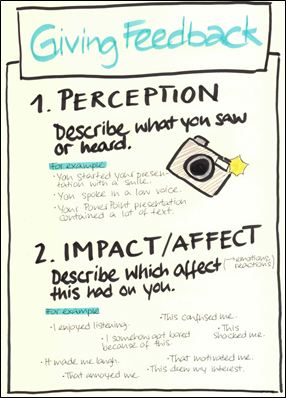Working on the Blind Spot - Giving and Receiving Feedback
The comparison of self-image and external image is a necessary requirement for the development of communicative skills. Feedback is the only way for us to learn about our "blind spot" (the unconscious part of our communicative behaviour, see Johari Window Model) and thus reduce it.
Giving feedback is not easy. Giving methodical feedback usually takes more than two lessons, and it requires patience and focus on the part of the teacher. Often we are so stuck in our everyday patterns, such as
- "Do I like this or not?"
- "What did he mean by that?"
- "How am I supposed to understand this?"
that we have to reflect on our thinking in order to be able to engage with giving feedback. Therefore, be sure to start with yourself and try out feedback in your everyday life (See here for more details regarding feedback).
What is feedback?
- It is a gift one is free to accept or not.
- It is descriptive.
- It is honest.
- It is subjective.
- It is concrete.
- It is direct.
- It is prompt.
- It is desired.
- It is constructive.
- It is balanced.
- It is referring to behaviours.
And what is it not?
- It is neither a judgement nor an assessment.
- It is not forced.
- It is not interpretive.
- It is not generalising.
Attention: Many students confuse feedback with criticism and want to hear “what they can do better”. But one of the most important goals of feedback is to recognise one's own strengths, not just to improve what is supposedly bad.
How to give feedback?
To introduce feedback and a real feedback culture in the course, it is useful to visualise the most important points and have them visible on the whiteboard or wall.
When giving feedback, it is the task for the feedback givers to
- Describe only
- What did you see? What did you hear?
- As exact as possible.
- Make it “photographable” (this avoids interpretations, assumptions and judgements)
- State the affect on their selves:
- How did it effect you?
- How did you feel?
- Giving some examples (on the whiteboard) can be helpful:
- It confused me.
- I had fun listening.
- It drew my interest.
- I got bored.
- It distracted me.
- It made me laugh.
- It shocked me.
- It motivated me.
- I enjoyed listening.
- It annoyed me.
Many curricula include student presentations. These are good for introducing methodical feedback in the group.
What methods of giving feedback can be used?
1. Unstructured Feedback
Objective
The students know the methodical steps for giving feedback. They can give feedback in a non-judgemental and constructive way with preparation.
Procedure
- The students give their presentation.
- The facilitator or teacher asks the students questions about how they have been and how they feel. This step is crucial. It gives space for the presenters' need to share. If you skip this, it is more likely that they will feel the need to comment, explain or justify during the feedback.
- The seminar group gives feedback to the presenters. Here, the students can take over moderation. Make sure that the presenters who receive feedback do not justify or apologise.
- The facilitator or teacher gives feedback. Facilitator feedback often pursues a didactic goal. Therefore, it can contain hints and suggestions, such as "Next time see if you can reduce your keyword concept: Formulated sentences can tempt you to look at the page a lot."
2. Structured Feedback
To enable even more detailed feedback from the group, there is the method of structured feedback. An additional advantage of this method is that the feedback givers additionally train their perception by focusing on specific areas.
Objective
The students know the methodical procedure for giving feedback as well as four feedback anchors or feedback categories. They are able to give feedback in a non-judgemental and constructive way.
Procedure
The so-called feedback anchors (categories written on cards) are distributed either to individuals or to groups, each focusing only on the corresponding category. The presenters can also distribute the anchors him or herself. The feedback anchors are redistributed before each presentation. The task for the feedback givers is to focus on their anchor while observing and giving feedback.
For example, these feedback anchors can be used for giving structured feedback for a presentation of students:
1. Body (nonverbal means)
- Facial expression
- Gestures
- Proxemics - the way a person moves in the room
- Eye contact
2. Speaking (paraverbal means)
- Voice
- Tone
- Accentuation
- Tempo
- Pauses
- Melody
- Volume
- Pronounication
3. Content
- Rigour
- Structure
- Emphasis and focus
4. Language (verbal means)
- Choice of words
- Sentence structure
- Vividness (examples, metaphors)



No Comments